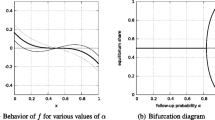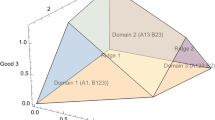Abstract
Following A Model of Sales by Varian (Am. Econ. Rev. 70(4):651–659, 1980) I study a model, in which shops compete for two different types of customer, informed and uninformed. I show that under these assumptions price cycles can occur and also show that these cycles are attracting. It turns out that these cycles do not have to correspond with the best response cycle for the game. But as simulations for higher dimensions suggest the occurring cycle is always unique.
Similar content being viewed by others
References
Benaïm M, Hofbauer J, Hopkins E (2009) Learning in games with unstable equilibria. J Econ Theory 144:1694–1709
Burdett K, Judd KL (1983) Equilibrium price dispersion. Econometrica 51:955–969
Cason TN, Friedman D (2003) Buyer search and price dispersion: a laboratory study. J Econ Theory 112:232–260
Cason TN, Friedman D, Hopkins E (2010) Testing the TASP: an experimental investigation of learning in games with unstable equilibria. J Econ Theory 145:2309–2331
Doyle J, Muehlegger E, Samphantharak K (2010) Edgeworth cycles revisited. Energy Econ 32:651–660
Edgeworth FY (1925) The pure theory of monopoly. Pap Relat Polit Econ 1:111–142
Hahn M (2009) Shapley polygons. PhD thesis, University College London
Hahn M (2010) Shapley polygons in 4×4 games. Games 1(3):189–220
Hofbauer J, Sigmund K (1998) Evolutionary games and population dynamics. Cambridge University Press, Cambridge
Hopkins E, Seymour RM (2002) The stability of price dispersion under seller and consumer learning. Int Econ Rev 43(4):1157–1190
Horn R, Johnson C (1985) Matrix analysis. Cambridge University Press, Cambridge
Lahkar R (2007) Essays in evolutionary game theory. PhD thesis, University of Wisconsin-Madison
Lahkar R (2011) The dynamic instability of dispersed price equilibria. J Econ Theory. doi:10.1016/j.jet.2011.05.014
Matsui A (1992) Best response dynamics and socially stable strategies. J Econ Theory 57(2):343–362
Maynard Smith J, Brown RLW (1986) Competition and body size. Theor Popul Biol 30:166–179
Noel MD (2007) Edgeworth price cycles, cost-based pricing, and sticky pricing in retail gasoline markets. Rev Econ Stat 89(2):324–334
Salop S, Stiglitz JE (1977) Bargains and ripoffs: a model of monopolistically competitive price dispersion. Rev Econ Stud 44(3):493–510
Varian HR (1980) A model of sales. Am Econ Rev 70(4):651–659
Author information
Authors and Affiliations
Corresponding author
Rights and permissions
About this article
Cite this article
Hahn, M. An Evolutionary Analysis of Varian’s Model of Sales. Dyn Games Appl 2, 71–96 (2012). https://doi.org/10.1007/s13235-011-0031-6
Published:
Issue Date:
DOI: https://doi.org/10.1007/s13235-011-0031-6




